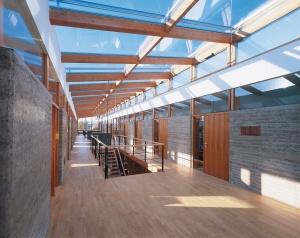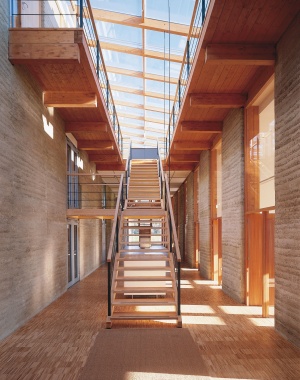Printing Plant Gugler
Pielach, Austria, 1998 - 1999
Client
Gugler GmbH
Architecture
Arch. Herbert Ablinger, Vedral&Partner
Builder
Lehm Ton Erde Baukunst GmbH
Rammed earth walls in series. The building planned by the architects Ablinger and Vedral&Partner, serves to the printshop and its 60 employees. It is structured into a large machine hall and a double loaded administrative wing, which connects to the southern long side of the factory floor. The offices and the other functional rooms are split up into a 2 to 3 floor northern part and into a 2 floor south part. The central hallway and common space serves as a circulation space, which is fully lighted due to the continuous glass roofing. The wooden stilt construction of the administrative wing was combined with 160 rammed earth, pre-casted elements in the format of 1,7 x 1,3 x 0,4m. The walls, fabricated in the Pise-technique, were planned by Martin Rauch and pervade the building in the longitude axis, serving optically and thermal for an ideal indoor atmosphere and temperature. Fresh air is absorbed through earthen air canals by the use of the soil temperature in the summer (cooling) and in the winter (pre-heating). Afterwards the air flows past the Pise-walls into the offices. Instead of accustomed radiators and air conditioning systems, the earthen walls function as hypokausts*: for comfortable radiating heat in the winter and for draft-free cooling effects in the summer.* A Hypokaustum or Hypokauste (greek hypokauston = „heating from below“) is a warm air heating system (Hypokaustenheating), by which a large building body is streamed by warm air, but which has in comparison with a radiator a lower surface temperature. Floors and walls or solid seating benches are used as solid warmth-carrying objects.

